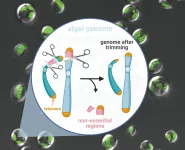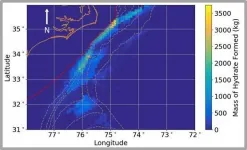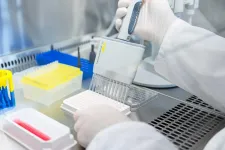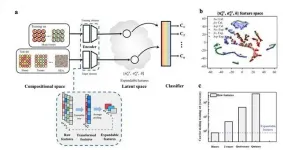Stimulating the immune system to fight cancer
Max Planck scientists from Dortmund find immunoregulatory substances with newly developed test system
2021-03-17
(Press-News.org) Our immune system is very successful when it comes to warding off viruses and bacteria. It also recognizes cancer cells as potential enemies and fights them. However, cancer cells have developed strategies to evade surveillance by the immune system and to prevent immune response.
In recent years, fighting cancer with the help of the immune system has entered into clinical practice and gained increasing importance as a therapeutical approach. Current therapies apply so-called immune checkpoint inhibitors. Immune checkpoints are located on the surface of cancer cells and slow down the immune response. Targeting these checkpoints can release this tumour-induced brake. Another strategy developed by cancer cells to escape the immune response is the production of the enzyme indoleamine-2,3-dioxygenase (IDO1), which metabolizes tryptophan into kynurenine and thereby interferes with the immune response in two ways: On the one hand, the depletion of tryptophan negatively impacts the growth of T cells, a central component of the immune response, which seek out and block cancer cells. On the other hand, the produced kynurenin inhibits T cells in the immediate environment of the cancer cells.
New Inhibitors against IDO1 - The Quest is on
IDO1 is in the focus of pharmaceutical research because of its cancer-driving effect. However, the search for IDO1 inhibitors has so far been only moderately successful and the first clinically tested IDO1 inhibitor, epacadostat, showed hardly any effect in clinical trials. However, it has not yet been possible to prove whether the inhibitor really blocks IDO1 in the tumour and whether the used dose is sufficient.
In drug discovery, experimental test procedures, so-called assays, are employed to search for new disease modulators in large libraries of thousands of compounds. For this purpose, mostly biochemical assays are applied, where a biochemical reaction is impaired if a substance shows an inhibitory effect in the assay. However, this method has certain disadvantages and limitations, as the test takes place in a test tube and not in the natural, cellular environment of the enzyme. For instance, enzymes like IDO1 are less stable and more reactive outside the protective shell of the cell. In addition, cell-free assays cannot detect indirect inhibitors of the enzyme, that for example interfere with its production or with essential co-factors.
Novel Cell-Based Assay Discovers IDO1 Inhibitors with Different Mechanisms of Action
Scientists led by Herbert Waldmann and Slava Ziegler have now developed a cell-based assay for the discovery of new IDO1 inhibitors that overcomes the limitations of cell-free assays. Elisabeth Hennes, PhD student at the MPI and first author of the study, employed a sensor that measures the conversion of the IOD1 substrate tryptophan into the metabolic product kynurenine in cell culture and thereby detects IDO1 activity. Based on this test strategy, several highly potent inhibitors with different mechanisms of action were identified from a library of more than 150,000 chemical substances: These include substances that directly switch off IDO1 as well as indirect inhibitors that prevent the production of IDO1 itself or that of its important cofactor heme.
"Unfortunately, previous attempts to find a compound that effectively stops the cancer-promoting activity of IDO1 in tumours have met with little success. However, the development of new compounds that can switch off IDO1 via different mechanisms of action could be a promising approach for immunotherapies in the fight against cancer. We hope that our newly developed cell-based assay could contribute to this area of research", says Slava Ziegler.
INFORMATION:
[Attachments] See images for this press release:

ELSE PRESS RELEASES FROM THIS DATE:
2021-03-17
A single-celled alga undergoes genome surgery to remove non-essential parts. This can lead to a most efficient cellular factory for producing sustainable biofuels from sunlight and carbon dioxide.
Researchers from the Qingdao Institute of BioEnergy and Bioprocess Technology (QIBEBT) of the Chinese Academy of Sciences (CAS) have stripped hundred-kilobase genome from a type of oil-producing microalgae, knocking out genes non-essential for it to function. By doing so, they have created a "genome scalpel" that can trim microalgal genomes rapidly and creatively.
The 'minimal genome' microalgae produced is potentially useful as a model organism for further study of the molecular and biological function of every gene, or as a 'chassis' strain for synthetic biologists to augment for customized ...
2021-03-17
RALEIGH, N.C. -- Methane hydrate, an ice-like material made of compressed natural gas, burns when lit and can be found in some regions of the seafloor and in Arctic permafrost.
Thought to be the world's largest source of natural gas, methane hydrate is a potential fuel source, and if it "melts" and methane gas is released into the atmosphere, it is a potent greenhouse gas. For these reasons, knowing where methane hydrate might be located, and how much is likely there, is important.
A team of researchers from Sandia National Laboratories and the U.S. Naval Research Laboratory have developed a new system to model the likelihood of finding methane ...
2021-03-17
Cutting-edge 3D scanners have been put to the test by researchers from the University of Southampton and partners Exceed Worldwide to help increase the quality and quantity of prosthetics services around the world.
The study, carried out within the END ...
2021-03-17
A team of scientists led by Dietmar Krautwurst from the Leibniz Institute for Food Systems Biology at the Technical University of Munich has now identified address codes in odorant receptor proteins for the first time. Similar to zip codes, the codes ensure that the sensor proteins are targeted from inside the cell to the cell surface, where they begin their work as odorant detectors. The new findings could contribute to the development of novel test systems with which the odorant profiles of foods can be analyzed in a high-throughput process and thus could be better controlled.
The ...
2021-03-17
Alchemy, which attempted to turn cheap metals such as lead and copper into gold, has not yet succeeded. However, with the development of alloys in which two or three auxiliary elements are mixed with the best elements of the times, modern alchemy can produce high-tech metal materials with high strength, such as high entropy alloys. Now, together with artificial intelligence, the era of predicting the crystal structure of high-tech materials has arrived without requiring repetitive experiments.
A joint research team of Professor Ji Hoon Shim and Dr. Taewon Jin (first author, currently at KAIST) of POSTECH's Department of Chemistry, and Professor Jaesik Park of POSTECH Graduate School of Artificial Intelligence have together developed a system that predicts ...
2021-03-17
TROY, N.Y. -- Numeric anchoring is a long-established technique of marketing communication. Once a price is mentioned, that number serves as the basis for -- or "anchors" -- all future discussions and decisions. But new research shows that this phenomenon is not limited to decisions that involve numbers, the use and understanding of which require high-level cognitive thinking. Anchoring also biases judgments at relatively low levels of cognition when no numbers are involved.
In research recently published in the Journal of Behavioral Decision Making, Gaurav Jain, an assistant professor in the Lally School of Management at Rensselaer Polytechnic Institute, demonstrated that anchoring even occurs in perceptual domains, ...
2021-03-17
Chemists all over the world are constantly searching for simple ways to make elemental nitrogen or N2 in the air available for chemical reactions. This is no easy task, as nitrogen is a particularly non-reactive gas with a triple bond, which is one of the strongest known chemical bonds. A research team at Friedrich-Alexander-Universität Erlangen-Nürnberg (FAU) has now demonstrated that calcium, a metal commonly found in nature, is able to break the highly-stable nitrogen bond and can do so at minus 60°C. This is significant for two reasons. On the one hand, the researchers at FAU have made a new discovery in terms of the bond-breaking capabilities of calcium, which had been largely disregarded in the past. On ...
2021-03-17
The snow may be melting, but it is leaving pollution behind in the form of micro- and nano-plastics according to a McGill study that was recently published in Environmental Pollution. The pollution is largely due to the relatively soluble plastics found in antifreeze products (polyethylene glycols) that can become airborne and picked up by the snow.
The researchers used a new technique that they have developed to analyze snow samples collected in April 2019 in Montreal for both micro- and nano-sized particles of various plastics. The McGill technique is orders of magnitude more sensitive than any of the other current methods used for tracing plastic in the environment. It ...
2021-03-17
Researchers at Rutgers School of Dental Medicine have found evidence that two types of mouthwash disrupt the COVID-19 virus under laboratory conditions, preventing it from replicating in a human cell.
The study, published in the journal Pathogens, found that Listerine and the prescription mouthwash Chlorhexidine disrupted the virus within seconds after being diluted to concentrations that would mimic actual use. Further studies are needed to test real-life efficacy in humans.
The study was conducted in a lab using concentrations of the mouthwash ...
2021-03-17
A study published March 16 in JAMA (the Journal of the American Medical Association) confirms that neither vitamin D nor the omega-3 fatty acids found in fish oil prevent the development of atrial fibrillation (AF), a potentially serious heart rhythm disturbance. The newly published research follows a presentation made by Christine Albert, MD, MPH, at the American Heart Association Scientific Sessions last year.
In their JAMA analysis, Albert and her research team also examined whether vitamin D or omega-3 fatty acids might have an impact on paroxysmal versus persistent atrial ...
LAST 30 PRESS RELEASES:
[Press-News.org] Stimulating the immune system to fight cancer
Max Planck scientists from Dortmund find immunoregulatory substances with newly developed test system






